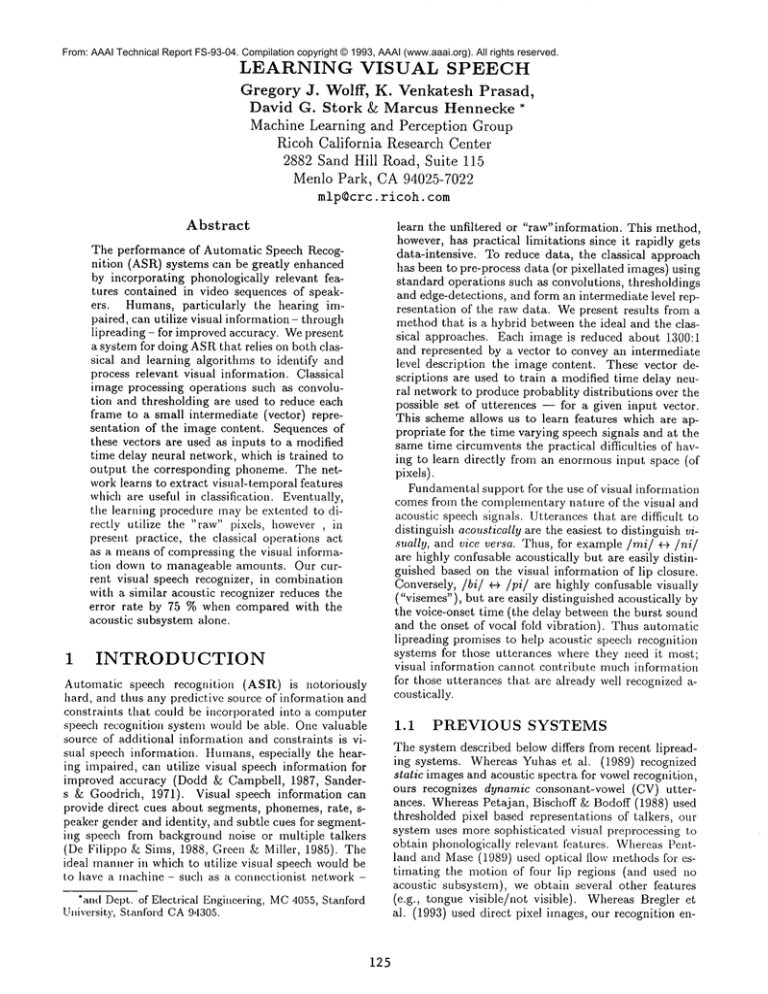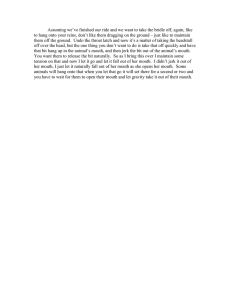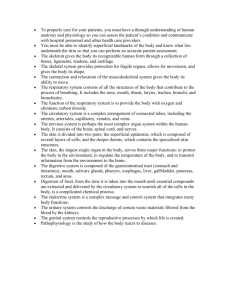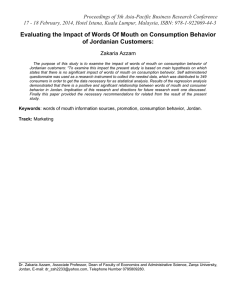
From: AAAI Technical Report FS-93-04. Compilation copyright © 1993, AAAI (www.aaai.org). All rights reserved.
LEARNING
VISUAL
SPEECH
Gregory
J. Wolff,
K. Venkatesh
Prasad,
David G. Stork
& Marcus Hennecke
*
Machine Learning and Perception
Group
Ricoh California
Research Center
2882 Sand Hill Road, Suite 115
Menlo Park, CA 94025-7022
mlp~crc, ricoh, com
Abstract
learn the unfiltered or "raw’information. This method,
however, has practical limitations since it rapidly gets
data-intensive. To reduce data, the classical approach
has been to pre-process data (or pixellated images) using
standard operations such as convolutions, thresholdings
and edge-detections, and form an intermediate level representation of the raw data. Wepresent results from a
method that is a hybrid between the ideal and the classical approaches. Each image is reduced about 1300:1
and represented by a vector to convey an intermediate
level description the image content. These vector descriptions are used to train a modified time delay neural network to produce probablity distributions over the
possible set of utterences -- for a given input vector.
This scheme allows us to learn features which are appropriate for the time varying speech signals and at the
same time circumvents the practical difficulties of having to learn directly from an enormous input space (of
pixels).
Fundamental support for the use of visual information
comes from the complementary nature of the visual and
acoustic speech signals. Utterances that are difficult to
distinguish acoustically are the easiest to distinguish visually, and vice versa. Thus, for example/mi/ +4/nil
are highly confusable acoustically but are easily distinguished based on the visual information of lip closure.
Conversely, /bi/ e+ /pi/ are highly confusable visually
("visemes"), but are easily distinguished acoustically
the voice-onset time (the delay between the burst sound
and the onset of vocal fold vibration). Thus automatic
lipreading promises to help acoustic speech recognition
systems for those utterances where they need it most;
visual information cannot contribute much information
for those utterances that are already well recognized acoustically.
The performance of Automatic Speech Recognition (ASR) systems can be greatly enhanced
by incorporating phonologically relevant features contained in video sequences of speakers. Humans, particularly
the hearing impaired, can utilize visual information- through
lipreading - for improved accuracy. Wepresent
a system for doing ASRthat relies on both classical and learning algorithms to identify and
process relevant visual information. Classical
image processing operations such as convolution and thresholding are used to reduce each
frame to a small intermediate (vector) representation of the image content. Sequences of
these vectors are used as inputs to a modified
time delay neural network, which is trained to
output the corresponding phoneme. The network learns to extract visual-temporal features
which are usefill in classification. Eventually,
the learning procedure may be extented to directly utilize the "raw" pixels, however , in
present practice, the classical operations act
as a means of compressing the visual informatiou down to manageable amounts. Our current visual speech recognizer, in combination
with a similar acoustic recognizer reduces the
error rate by 75 % when compared with the
acoustic subsystem alone.
1
INTRODUCTION
Automatic speech recognition (ASR) is notoriously
hard, and thus any predictive source of information and
constraints that could be incorporated into a computer
speech recognition system would be able, One valuable
source of additional information and constraints is visual speech information. Humans, especially the hearing impaired, can utilize visual speech information for
improved accuracy (Dodd ~: Campbell, 1987, Sanders & Goodrich, 1971). Visual speech information can
provide direct cues about segments, phonemes, rate, speaker gender and identity, and subtle cues for segmenting speech from background noise or multiple talkers
(De Filippo & Sims, 1988, Green & Miller, 1985). The
ideal manner in which to utilize visual speech would be
to have a machine - such as a connectionist network -
1.1
PREVIOUS
SYSTEMS
The system described below differs from recent lipreading systems. Whereas Yuhas et al. (1989) recognized
static images and acoustic spectra for vowel recognition,
ours recognizes dynamic consonant-vowel (CV) utterances. Whereas Petajan, Bischoff & Bodoff (1988) used
thresholded pixel based representations of talkers, our
system uses more sophisticated visual preprocessing to
obtain phonologically relevant features. Vv’hereas Pentland mid Mase (1989) used optical flow methods for estimating the motion of four lip regions (and used no
acoustic subsystem), we obtain several other features
(e.g., tongue visible/not visible). Whereas Bregler
al. (1993) used direct pixel images, our recognition en-
*and Dept. of Electrical Engineering, MC4055, Stanford
Stanford CA9,1305.
University,
125
gine used a far more compressed visual representation;
our methodof integration, too, was based on statistical
properties of our data. Webuild upon the basic architectural recognizer of Stork, Wolff and Levine (1992),
but extend it to grayscale input.
2
VISUAL
PREPROCESSING
The sheer quantity of image data presents a hurdle to
utilizing video information for speech recognition. Our
approach to video preprocessing makes use of several
simple computations to reduce the large amount of data to a manageableset of low-level image statistics describing the region of interest around the mouth. These
statistics capture such features as tile positions of the
upl)er and lower lip, the mouth shape, and their time
derivatives. The rest of this section describes the computation of these features in detail.
Grayscale video images are captured with a standard
NTSCcamera, and subsampled to give 150 x 150 pixel
image at 30 frames/second. A 64 x 64 pixel region of
interest (ROI) is detected and tracked by means of the
following operations on the full video images:
¯ Convolvewith 3 × 3 pixel low-pass filter
(to removespatial noise)
plxel p~ltlon
Figure 1: A subregion of the ROI found automatically in two frames of the video sequence of the utterance
"ba" and their associated luminance profiles along the
central line marked. (Only the central vertical strip of
32 x64 pixels is shown.) Notice that the lowest valley in this profile changes drastically in gray level as the
mouthchanges from closed to open. In addition, the linear separation between the peaks adjacent to the lowest
valley also increases as the mouth opens. The position
and speeds of these peaks and valleys, as well as other
features, provide input to our recognizer.
¯ Convolvewith 3 × 3 pixel edge detector
(to detect edges)
¯ Threshold at (Im,,x - Imm)/2
(to isolate eyes and mouth)
¯ Triangulate eyes with mouth
(to obtain ROI)
Wealso use temporal coherence in frame-to-frame correlations to reduce the effects of noise in the profile or missiug data (such as "closed" eyes). Within the ROI the
phonological features are found by the following steps
(see Figure 1):
2.1
FEATURES
The seventeen features are:
¯ Horizontal separation between the left and right
mouth corners
¯ Vertical separation between the top and bottom lips
For each of the three vertically aligned positions:
¯ Vertical speed, based on iuterframe positions:
¯ Convolvewith 16 x 16 pixel low-pass filter
(to removenoise)
¯ Extract a vertical grayscaleprofile
(candidates for teeth, tongue)
Ape/eat
¯
¯
For
¯
¯ Extract a horizontal grayscale profile
(mouth width)
¯ Locate and label grayscale peaks and valleys
(candidates for teeth, tongue)
¯ Calculate interframe peak motion
(speed estimates)
Video preprocessing tasks including the temporal averaging are usually complicated because of the pixel correspondence problem has to be solved. Wecircumvent
this correspondence problem by matching labeled features (such as a grayscale valley on successive frames).
A similar process is performed along the horizontal
cut through the ROI in order to obtain mouth width
information. The ratio of the mouth width to mouth
height gives an estimate of the eccentricity, whichdiffers
drastically, for instance, between "i" and "oo."
plxelp~,ltlon
Graylevel value: G
Change in graylevel versus time: Lxa
At
both of the mouth corner positions:
Horizontal speed, based on interframe positions:
APh
At
¯ Graylevel value, G
¯ Changein graylevel versus time: A___q
At
For each talker, each feature was scaled have a zero
mean value and a standard deviation of 1.0.
3
DATA COLLECTION
NETWORK
TRAINING
AND
We trained the modified time delay neural network
shown in figure 3 on both the video and acoustic data. (See Stork, Wolff and Levine (1992) for a complete
description of the architecture.) For the video (V0) network, the input layer consists of 24 samplesof each of the
126
Figure 2: Tile (approximate) ROIand key points located and tracked automatically by the method described
above. The seventeen video feature consist of the horizontal separation of the right and left positions of the
mouth corners, the vertical separation between the upper and lower lip positions and at each of the five positions shown, the gray level, the position (either vertical or horizontal) speed, and the time derivatives of the
graylevels.
17 features, corresponding to roughly 0.8 seconds. Each
(sigmoidal) hidden unit received signals from a receptive
field of 17 features for five consecutive frames. Each of
the different hidden units (there were 3 for the results
reported below) is replicated to cover the entire input
space with overlapping receptive fields. The next layer
consisted of 5 rows of x-units (one row for each possible
utterance), with exponential transfer functions. They
received inputs from the hidden units for 11 consecutive
frames, thus they indirectly received input from a total
of 18 input frames corresponding to roughly 0.6 seconds. The activities of the x-units encode the likelihood
that a given letter occurs in that interval. The final
layer consists of five p-units (probability units), which
encode the relative probabilities of the presence of each
of the possible utterances across the entire input window. Each p-unit sums the entire row of corresponding
x-units, normalized by the sum over all x-units.
The acoustic only (AO) network shared the same architecture, except that the input consisted of 100 frames
of 14 reel scale coefficients each, and the x-units received
fan in from a 25 consecutive hidden units.
These networks were trained using Backpropagario. to minimize the Kullback-Leibler distance (crossentropy) between the targets and outputs.
E = D(t II P) = ~--~ti ln(,~.)
(1)
i
llere the target probability is 1.0 for the target category,
and 0 for all other categories. In this case Equation 1
simplifies to E = ln(p~) where e is the correct category.
In the TDNN
architecture, weights are shared, i.e., the
pattern of input-to-hidden weights is forced to be the
Figure 3: Time delay neural network (cf. Stork, Wolff
and Levine, 1992).
same at each interval. (Weights linking the x-units and
p-units are fixed.) Thus the total number of independent
weights in this VOnetwork is 428, and 593 for the AO
network.
3.1
SENSORY
INTEGRATION
Given the output probability distributions of the two
networks, we combine them assuming conditional independence and using Bayes rule to obtain:
P(cilA,
P(AM)P(Vlei)P(ci)
V) = ~N=~
p(Alcj)P(Vlcj)P(cj
) (2)
That is, the joint probability of the utterance belonging to category i is just the normalized product of the
outputs for category i of each network.
This "independent opinion pooling "(Berger, 1985)
offers several advantages over other methods for combining the modalities. First, it is optimal if the two signals really are conditionally independent, which appears
to be the case for our data. (Proving that two signals
are not conditionally independent is difficult.) In fact,
Massaro (1983) has shown that human recognition performance is consistent with the independence assumption. A second advantage is simplicity. The combination
adds no extra parameters beyond those used to model
each signal, thus generalization performance should be
good. Furthermore, the independent recognizers can be
developed and trained separately, the only requirement
is that they both output probability estimations.
A third advantage is that this system automatically
compensates for noise and assigns more importance to
the network which is most sure of its classification. For
example, if the video data were very noisy (or missing),
the video network would judge all utterances equally
likely. In this case the video contribution would cancel
out, and the final output probabilities would be determined solely by the audio network. Bregler et al. at-
127
Video Test
AudioTe6t
one domain are resolved by information from the other
domain.
Av Test
5
., 0 0 0 " °
b, Qo 0 ’ ¯
ca rl I| ma
b,
AND
A hybrid approach to learning visual speech for the purpose of improving the performance of automatic speech
recognition (ASR) systems has been presented here.
The approach involves video pre-processing as a means of reducing the visual speech information to a manageable level. While results indicate that even the
straightforward and computationally simple methods,
such as image convolutions and grey-level thresholdings,
we have employed can significantly
enhance ASRour
pre-processing approach does suffer from being at least
partially hand-crafted, such as in the choice of the support sizes of the convolution kernels, and application
specific. Issues such as how visual speech can be learnt
and visual data redundancy can be eliminated are important open issues that we would like to address in the
future.
~ ca ~ Ii ma
Figure 4: Confusion matrices for the video only (VO),
coustic only (AO), and the A×Vnetworks. Each vertical
colunmis labeled by the spoken CVpair presented as input;
each horizontal row represents the output by the network.
The radius of each disk in the array is proportional to the
output probability given an input utterance, The recognition
accuracy (measured as a percentage of novel test patterns
properly classified by maximum
network output) is shown.
tempt to compensate for the variance between channels
by using the entropy of the output of the individual networks as a weighting on their contribution to the final
outputs. Their ad hoc method suffers several drawbacks. For example, it does not distinguish the case where a
one category is highly likely and the rest equiprobable,
fi’om the case where several categories are moderately
likely.
A final advantage of Equation 2 is that it does not
require synchrony of the acoustic and visual features.
Tile registration between the two signals could be off
substantially (as long as the same utterance is present in
the input to both networks). On the contrary, methods
which attempt to detect cross-modal features would be
very sensitive to the relative timing of the two signals.
4
CONCLUSIONS
OPEN ISSUES
References
RESULTS
The video and audio networks were trained separately
on several different consonants in the same vowel context (/ba/, /da/, /fa/, /la/,/ma/) recorded from several different speakers. (For the results reported below,
there were 4 speakers, repeating each CVpair 5 times.
Four of these were used for training, and one for testing
generalization.)
As expected, the audio network performs better than
the video network. For typical video networks, the correct classification (using the Maxdecision rule) on unscen data is typically 50-65%,and for the audio networks, 00-80%. Figure 4 shows the confusion matrices for
the network outputs. Wecan see that the audio network
is fairly diagonal with some confusions between /da/,
/ba/ and /fa/. The video network is making more and
different errors, for example, confusing /la/and/ma/.
The performance for the combined outputs (the AV
network) is much better than either of the individual
networks, achieving classification rates in the 90-98%
range. Wealso see a strongly diagonal confusion matrix
lbr the AVnetwork, indicating that the confusions in
128
[Berg82]
R. Berg & D. G. Stork. (1982) The
Physics of Sound. Englewood Cliffs
N J: Prentice-Hall.
[Berger85]
J.O. Berger. (1985) Statistical decision theory and Bayesian analysis (2nd ed.). 272-275, NewYork:
Springer-Verlag.
[Binnie74]
C.A. Binnie,
A. Montgomery &
P. Jackson. (1974). Auditory and visual contributions to the perception
of consonants. J. Speech and Hearing
Res. 17, 619-630.
[DeFilippo88]
C. L. De Filippo £5 D. G. Sims (eds.), (1988) NewReflections on
Speechreading (Special issue of The
Volta Review). 90(5).
[Dodd87]
B. Dodd & R. Campbell (eds.).
(1987) Hearing by Eye: The Psycholo9y of Lip-readin9. Hillsdale, N J:
Lawrence Erlbaum Press.
[Duda74]
R. O. Duda, P. E. Hart & D. G. Stork. (1995) Pattern Classification
and Scene Analysis (2nd ed.). New
York: Wiley Interscience (in preparation).
[Green85]
K. P. Green & J. L. Miller. (1985)
the role of visual rate information in
phonetic perception. Perception and
Psychophysics 38,269-276.
[Fisher68]
C. G. Fisher. (1968) Confusions
mongvisually perceived consonants.
J. Speech and Hearin9 Res. 11, 796804.
[Keeler92]
[Massaro83]
J. D. Keeler, D. E. Rumelhart &
W.-K. Leow. (1992) Integrated segmentation and recognition of handprinted numerals. In R. P. Lippmann, J. E. Moody & D. S. Touretzky
(eds.), Advances in Neural Information Processing Systems 3, 557-563.
San Mateo, CA: Morgan Kaufmann.
D. W. Massaro & M. M. Cohen
(1983) Evaluation and integration
of visual and auditory information
in speech perception J. Exp. Psych:
HumanPercep. and Perf. 9,753-771.
[McGurk76]
H. McGurk & J. MacDonald. (1976)
Hearing lips and seeing voices. Nature 264,746-748.
[Miller55]
G. A. Miller, G. A. & P. E. Nicely. (1955) An analysis of perceptual
confusions among some English consonants. J. Acoustical Soc. Am. 27,
338-352.
A. Pentlaud & I(. Mase (1989)
reading: Automatic visual recognition of spoken words. PTvc. Image
Under. and Machine Vis., Optical
Society of America, June 12-14.
E. D. Petajan, B. Bischoff & D. Bodoff. (1988) An improved automatic
lipreading system to enhance speech
recognition. ACMSIGCHI-88,19-25.
[Pentland89]
[Petajan88]
[Sanders71]
[Sumby54]
[Summer84]
D. Sanders & S. Goodrich. (1971)
The relative contribution of visual
and auditory components of speech
to speech intelligibility as a function
of three conditions of frequency distortion. J. Speech and Hearing Res.
14, 154-159.
W. H. Sumby& I. Pollack. (1954) Visual contribution to speech intelligibility in noise. J. Acoustical Soc. Am.
26, 212-215.
A. Q. Summerfield & M. McGrath.
(1984) Detection and resolution
audio-visual incompatibility in the
perception of vowels. Quart. J. Exp.
Psych. 36, 51-74.
[Waibe189]
A. Waibel. (1989) Modular construction of time-delay neural networks for
speech recognition. Neural Computation 1, 39-46.
[Yuhas88]
B. P. Yuhas, M. H. Goldstein, Jr.,
T. J. Sejnowski & R. E. Jenkins.
(1988) Neural network models of sensory integration for improved vowel recognition. Proc. IEEE 78(10),
1658-1668.
129






